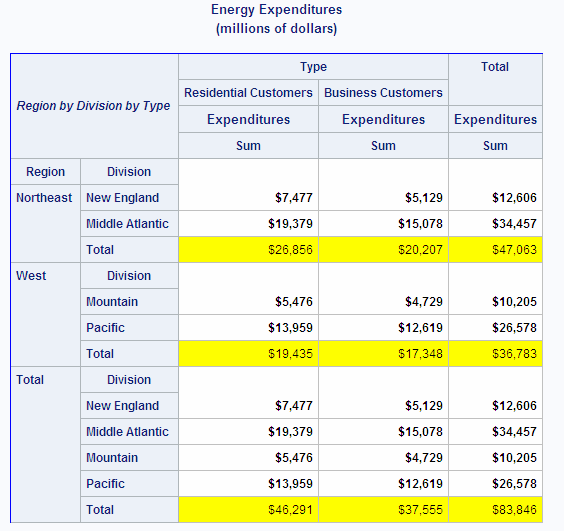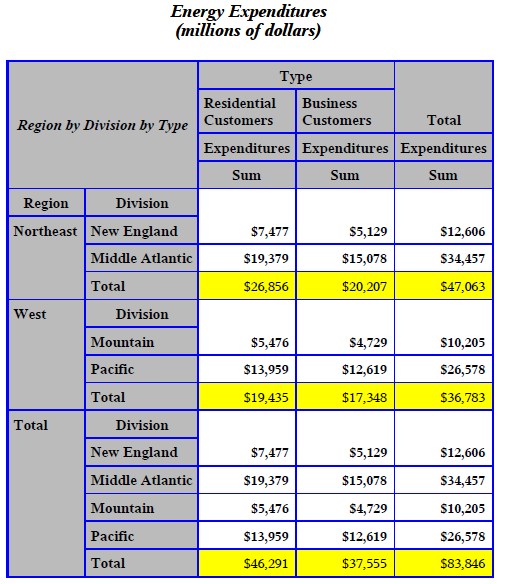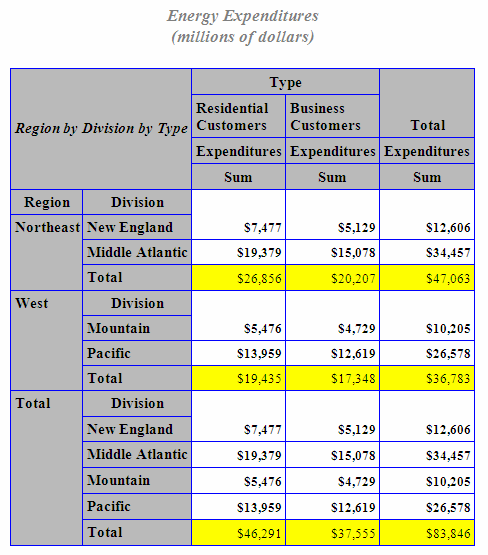TABULATE Procedure
- Syntax

- Overview
- Concepts
- Using
- Results
- Examples
 Creating a Basic Two-Dimensional TableSpecifying Class Variable Combinations to Appear in a TableUsing Preloaded Formats with Class VariablesUsing Multilabel FormatsCustomizing Row and Column HeadingsSummarizing Information with the Universal Class Variable ALLEliminating Row HeadingsIndenting Row Headings and Eliminating Horizontal SeparatorsCreating Multipage TablesReporting on Multiple-Response Survey DataReporting on Multiple-Choice Survey DataCalculating Various Percentage StatisticsUsing Denominator Definitions to Display Basic Frequency Counts and PercentagesSpecifying Style Elements for ODS OutputStyle PrecedenceNOCELLMERGE Option
Creating a Basic Two-Dimensional TableSpecifying Class Variable Combinations to Appear in a TableUsing Preloaded Formats with Class VariablesUsing Multilabel FormatsCustomizing Row and Column HeadingsSummarizing Information with the Universal Class Variable ALLEliminating Row HeadingsIndenting Row Headings and Eliminating Horizontal SeparatorsCreating Multipage TablesReporting on Multiple-Response Survey DataReporting on Multiple-Choice Survey DataCalculating Various Percentage StatisticsUsing Denominator Definitions to Display Basic Frequency Counts and PercentagesSpecifying Style Elements for ODS OutputStyle PrecedenceNOCELLMERGE Option - References
Example 14: Specifying Style Elements for ODS Output
| Features: |
|
| Other features: |
ODS HTML statement ODS PDF statement ODS RTF statement |
| Data set: | ENERGY |
| Formats: | REGFMT. |
Program
options nodate pageno=1;
ods html body='external-HTML-file'; ods pdf file='external-PDF-file'; ods rtf file='external-RTF-file';
proc tabulate data=energy style=[fontweight=bold];
class region division type / style=[textalign=center];
classlev region division type / style=[textalign=left];
var expenditures / style=[fontsize=3];
keyword all sum / style=[fontwidth=wide]; keylabel all="Total";
table (region all)*(division all*[style=[backgroundcolor=yellow]]),
(type all)*(expenditures*f=dollar10.) /
style=[bordercolor=blue]
misstext=[label="Missing" style=[fontweight=light]]
box=[label="Region by Division by Type"
style=[fontstyle=italic]];
format region regfmt. division divfmt. type usetype.;
title 'Energy Expenditures'; title2 '(millions of dollars)'; run;
ods html close; ods pdf close; ods rtf close;
Program Description
Set the SAS system options.The
NODATE option suppresses the display of the date and time in the output.
PAGENO= specifies the starting page number. LINESIZE= and PAGESIZE=
are not set for this example because they have no effect on HTML,
RTF, and Printer output.
Specify the ODS output filenames.By opening multiple ODS destinations, you can produce
multiple output files in a single execution. The ODS HTML statement
produces output that is written in HTML. The ODS PDF statement produces
output in Portable Document Format (PDF). The ODS RTF statement produces
output in Rich Text Format (RTF). The output from PROC TABULATE goes
to each of these files.
ods html body='external-HTML-file'; ods pdf file='external-PDF-file'; ods rtf file='external-RTF-file';
Specify the table options.The
STYLE= option in the PROC TABULATE statement specifies the style element
for the data cells of the table.
Specify subgroups for the analysis.The STYLE= option in the CLASS statement specifies
the style element for the class variable name headings.
Specify the style attributes for the class variable value
headings.The STYLE= option in the CLASSLEV
statement specifies the style element for the class variable level
value headings.
Specify the analysis variable and its style attributes.The STYLE= option in the VAR statement specifies
a style element for the variable name headings.
Specify the style attributes for keywords, and label the
“all” keyword. The STYLE=
option in the KEYWORD statement specifies a style element for keywords.
The KEYLABEL statement assigns a label to the keyword.
Define the table rows and columns and their style attributes.The STYLE= option in the dimension expression overrides
any other STYLE= specifications in PROC TABULATE that specify attributes
for table cells. The STYLE= option after the slash (/) specifies attributes
for parts of the table other than table cells.
table (region all)*(division all*[style=[backgroundcolor=yellow]]),
(type all)*(expenditures*f=dollar10.) /
style=[bordercolor=blue]Specify the style attributes for cells with missing values.The STYLE= option in the MISSTEXT option of the TABLE
statement specifies a style element to use for the text in table cells
that contain missing values.
Specify the style attributes for the box above the row
titles.The STYLE= option in the BOX
option of the TABLE statement specifies a style element to use for
text in the box above the row titles.


